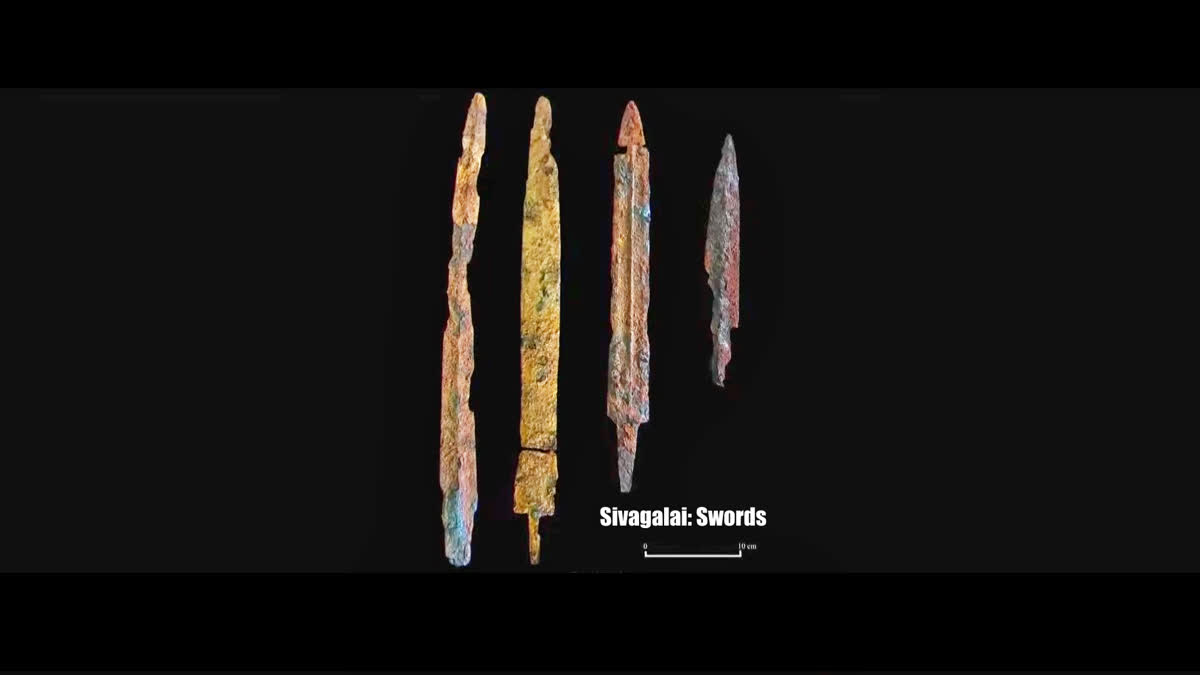Chennai: I can confidently say iron smelting technology was prevalent in Tamil Nadu at least for about 5300 years ago, Chief Minister MK Stalin announced on Thursday.
He made the revelation while releasing a research book, Antiquity of Iron(Recent radiometric dates from Tamil Nadu), a publication of the state department of archaeology.
The study is backed by tests carried out in different reputed labs to ascertain the age of the iron artefacts including swords recovered from burial urns in Sivagalai excavation site in Thoothukudi district.
Prof. K. Rajan, Academic and Research Advisor, Tamil Nadu State Department of Archaeology, and R. Sivanantham, Joint Director, Tamil Nadu State Department of Archaeology, are the lead authors of the book.
The pride is real
"For the critiques that deride "Tamil is the oldest of races" as full of (empty) pride, I tell you that the age of iron began from the land of Tamils," Stalin harped.
"I proclaim this to the world as an anthropological research finding. The technology of iron smelting was introduced in Tamil Nadu 5300 years ago," he said.
The CM said the time calculations were based on recent studies and that those had put the period in which the iron was introduced here to pre-4000 BC. "I am announcing this as the research findings."
The samples collected from a single burial urn from the archaeological site were sent to Beta Analytics in Florida state in the United States, which uses gold-standard methods for radiocarbon analysis. The same were sent to the Birbal Sahni Institute of Palaeosciences, Lucknow and the Physical Research Laboratory, Ahmedabad, both premier institutes that fall under the ambit of the Department of Science and Technology of the union government.
The samples from the same burial urn were sent for analysis in these institutions the national institutes were asked to carry out OSL(Optically stimulated luminescence) analysis and the international institute was asked to carbon date the sample.
"The results from these three different analyses were peer-reviewed and it has been established that the iron has been in use in south India before 3500 BC," the CM said. The results were shared with leading archaeologists in the country, who are researching the emergence of iron use and its smelting technology in India, he said.
"Therefore, we have scientifically established the fact that the use of iron was prevalent in Tamil Nadu 5300 years ago. We can tell this with a sense of pride as this is a gift of Tamil Nadu not only to India but to the entire world," he said.
The book published today also bears the reactions from the leading archaeologists who have pored over the findings and the test results, the CM said.
The findings, according to Stalin, will have a positive bearing on the future archaeological excavations and its connected research work here in the state.
Stalin who has been insisting that "the history of India should be written from Tamil Nadu", said the work by our state-run archaeological department keeps proving him right on that.
Dilip Kumar Chakrabarti, Professor Emeritus of South Asian Archaeology at Cambridge University, said that he was emotional to hold a copy of Antiquity of Iron, as an Indian and octogenarian archaeologist.
He said this while raising a copy of the book to the audience and holding his walking crutch in another.
It has been an honour for this state department of Tamil Nadu archaeology to discover the first time in the world that smelted iron can go back to the 3rd millennium BC.
He termed it as a discovery of not merely Indian significance "but also in the context of the archaeology of the world." Many years ago, perhaps sixty years ago when I was a student, we studied that the antiquity of Iron does not go beyond 6 century BC, he recalled. "Now from the 6th century to about 2500 BC, as you can see, this is a very very big jump."
Changes antiquity of writing
The Padma Shri awardee said he was proud to witness this confirmation in his lifetime. He said: "Apart from the discovery of the earliest iron in the world, it has contributed significantly to another aspect of Indian culture, the antiquity of writing. Writing has been usually, how do I put it? Writing does not go beyond the reign of Ashoka. Now, Tamil Nadu state archaeology has proved through radiocarbon dates and through the study of different types of graffiti that the antiquity of writing in India goes back to the 7th century BCE."
Prof. Osmund Bopearachchi lauded the researchers for documenting and precise mapping of all the major iron smelting sites.
Bopearachchi who is currently the Emeritus Director of Research, French National Centre for Scientific Research, Paris, also appreciated the scientific methodology employed in producing the research, in his comments on the finding. "The new dating proposed in the book radically alters the old chronology. Radiocarbon dating drastically modifies the chronology of the first iron smelting furnaces in Tamil Nadu."
